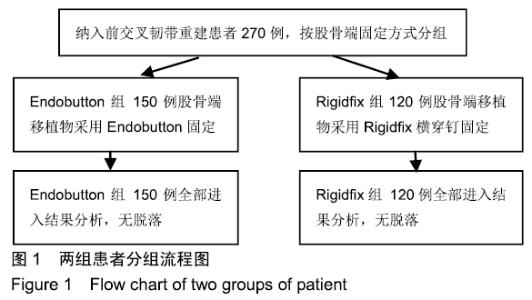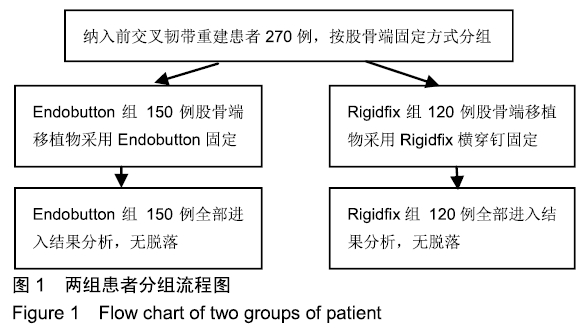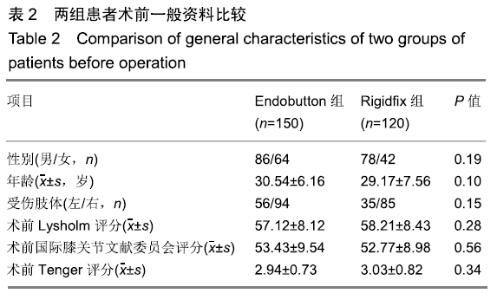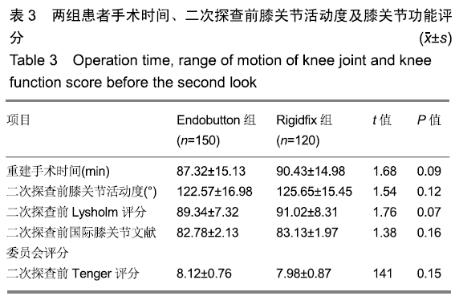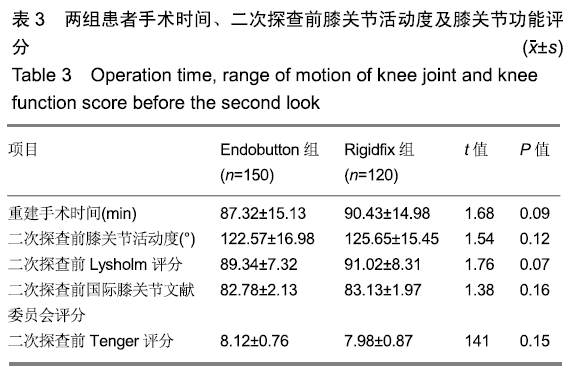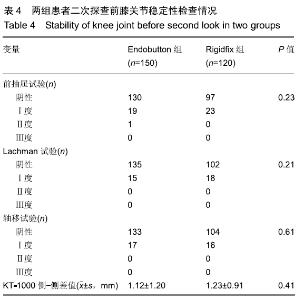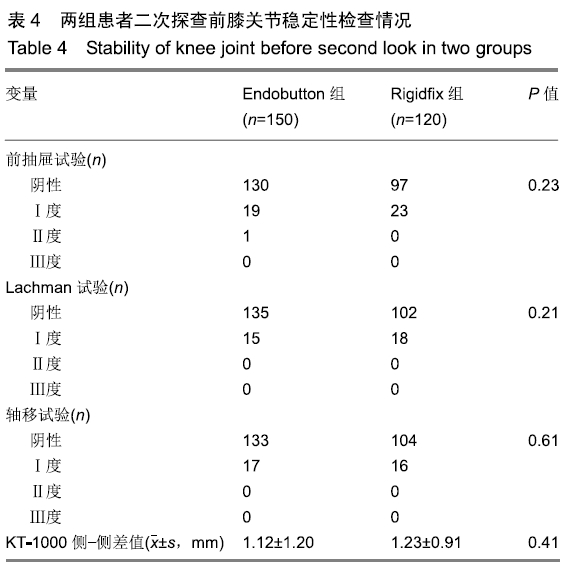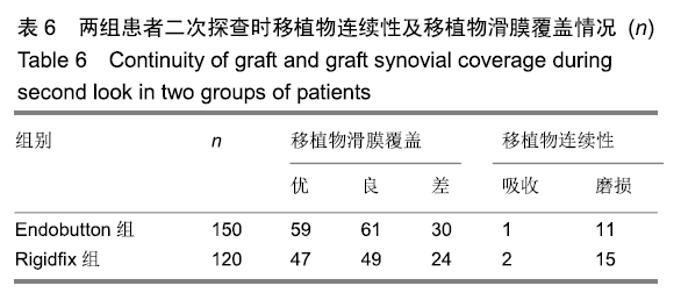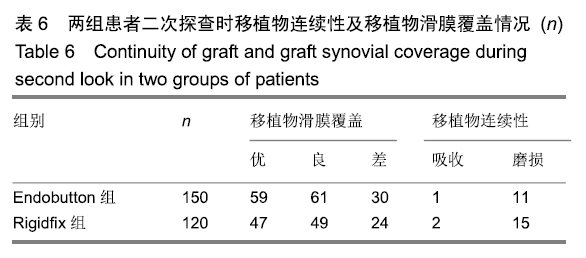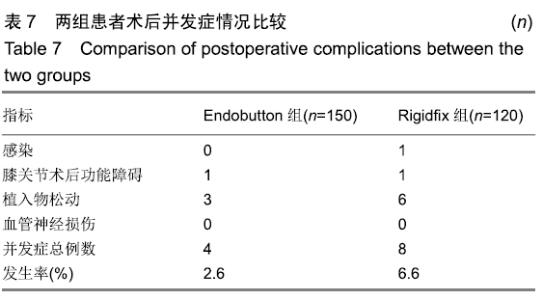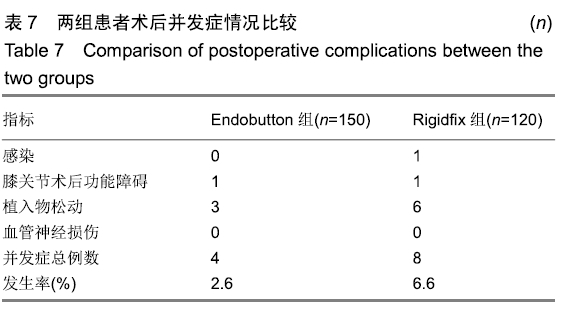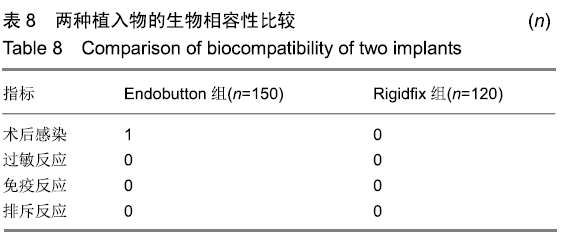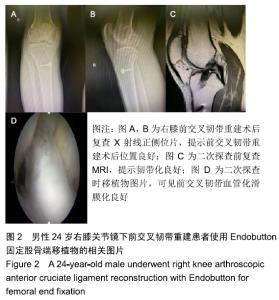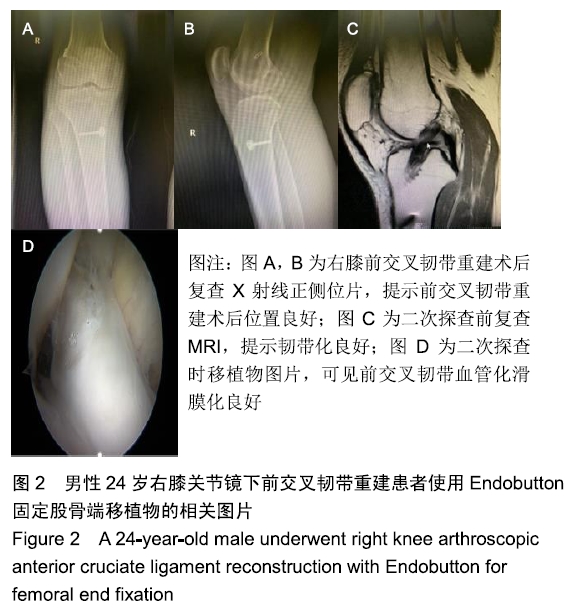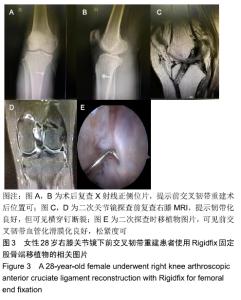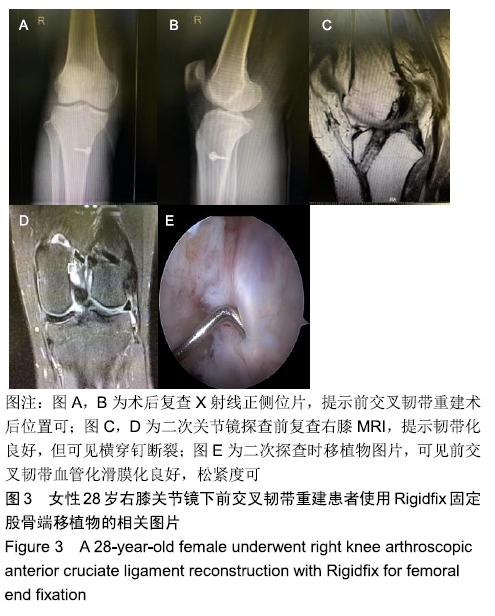Chinese Journal of Tissue Engineering Research ›› 2020, Vol. 24 ›› Issue (3): 359-365.doi: 10.3969/j.issn.2095-4344.2409
Previous Articles Next Articles
Outcomes of Endobutton and Rigidfix femoral fixation methods with hamstring autograft in anterior cruciate ligament reconstruction
Zhao Lilian, Lu Mingfeng, Xing Jisi, He Lilei, Xu Ting, Wang Changbing
- Department of Sports Medicine, Foshan Hospital of Traditional Chinese Medicine, Foshan 528000, Guangdong Province, China
-
Received:2019-03-20Revised:2019-03-30Accepted:2019-05-16Online:2020-01-28Published:2019-12-25 -
About author:Zhao Lilian, MD, Associate chief physician, Associate professor, Department of Sports Medicine, Foshan Hospital of Traditional Chinese Medicine, Foshan 528000, Guangdong Province, China -
Supported by:the Research on Medical Science and Technology in Guangdong Province, No. 20161181228306; the Scientific Research Project of Guangdong Traditional Chinese Medicine Bureau, No. 20192095
CLC Number:
Cite this article
Zhao Lilian, Lu Mingfeng, Xing Jisi, He Lilei, Xu Ting, Wang Changbing. Outcomes of Endobutton and Rigidfix femoral fixation methods with hamstring autograft in anterior cruciate ligament reconstruction [J]. Chinese Journal of Tissue Engineering Research, 2020, 24(3): 359-365.
share this article
Add to citation manager EndNote|Reference Manager|ProCite|BibTeX|RefWorks
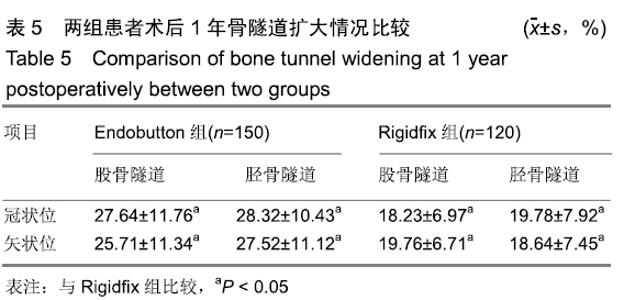
Endobutton组及Rigidfix组KT-1000侧-侧差值对比,差异无显著性意义(P > 0.05),见表4。 2.6 术后1年MRI复查2组患者骨隧道扩大情况 术后Endobutton组股骨端和胫骨端骨隧道扩大均较Rigidfix组明显。其中冠状位术后股骨隧道扩大2组差异有显著性意义(t=7.74,P=0.00),矢状位术后股骨隧道扩大2组差异也有显著性意义(t=5.07,P=0.00)。冠状位术后胫骨隧道扩大2组差异有显著性意义(t=7.41,P=0.00),矢状位术后2组胫骨隧道扩大差异也有显著性意义(t=7.50,P=0.00)。2组股骨隧道和胫骨隧道扩大情况比较,差异均有显著性意义(P < 0.05),见表5。 "
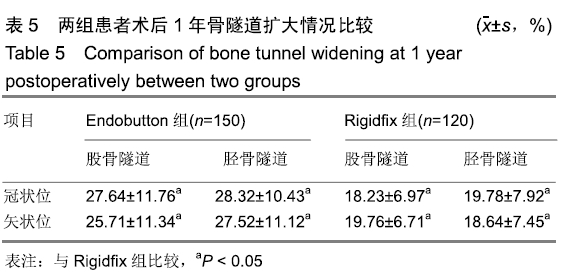
| [1] CHEN H, CHEN B, TIE K, et al. Single-bundle versus double-bundle autologous anterior cruciate ligament reconstruction: a meta-analysis of randomized controlled trials at 5-year minimum follow-up. J Orthop Surg Res.2018; 13(1):50. [2] CHEN Y, CHUA KH, SINGH A, et al. Outcome of single-bundle hamstring anterior cruciate ligament reconstruction using the anteromedial versus the transtibial technique: a systematic review and meta-analysis. Arthroscopy. 2015;31(9):1784-94. [3] AGA C, WILSON KJ, JOHANSEN S, et al. Tunnel widening in single- versus double-bundle anterior cruciate ligament reconstructed knees. Knee Surg Sports Traumatol Arthrosc. 2017;25(4): 1316-1327. [4] MERMERKAYA MU, ATAY OA, KAYMAZ B, et al. Anterior cruciate ligament reconstruction using a hamstring graft: a retrospective comparison of tunnel widening upon use of two different femoral fixation methods. Knee Surg Sports Traumatol Arthrosc. 2015;23(8): 2283-2291. [5] 常晗,唐翔宇,曲峰,等.关节镜下前交叉韧带重建移植物固定方式选择的研究进展[J].中国骨伤,2017,30(4):234-238. [6] COLVIN A, SHARMA C, PARIDES M, et al. What is the best femoral fixation of hamstring autografts in anterior cruciate ligament reconstruction? a meta-analysis. Clin Orthop Relat Res.2011;469(4):1075-1081. [7] MOISALA AS, JÄRVELÄ T, PAAKKALA A, et al. Comparison of the bioabsorbable and metal screw fixation after ACL reconstruction with a hamstring autograft in MRI and clinical outcome: a prospective randomized study. Knee Surg Sports Traumatol Arthrosc. 2008;16(12):1080. [8] KIM MK, LEE SR, HA JK, et al. Comparison of second-look arthroscopic findings and clinical results according to the amount of preserved remnant in anterior cruciate ligament reconstruction. Knee. 2014;21(3):774-778. [9] FAUNO P, KAALUND S. Tunnel widening after hamstring anterior cruciate ligament reconstruction is influenced by the type of graft fixation used: A prospective randomized study. Arthroscopy. 2005; 21(11):1337-1341. [10] TO J, HOWELL S, HULL M. Contributions of femoral fixation methods to the stiffness of anterior cruciate ligament replacements at implantation. Arthroscopy. 1999;15(4):379-387. [11] 马文娟,张开伟.前交叉韧带重建股骨隧道悬吊固定方式对骨道及移植物变化的近期影响[J]. 中国组织工程研究, 2016,20(35):5284-5289. [12] FU FH, SCHULTE KR. Anterior cruciate ligament surgery 1996. State of the art? Clin Orthop Relat Res.1996;325(325):19-24. [13] MALHAN K, KUMAR A, REES D. Tibial cyst formation after anterior cruciate ligament reconstruction using a new bioabsorbable screw. Knee.2002;9(1):73-75. [14] RAJU V, KUMAR AA, SACHIN I, et al. Current trends in anterior cruciate ligament reconstruction: a review. Cureus. 2015;7(11):378. [15] 翟溶凡. 前交叉韧带重建中EndoButton和RigidFix两种股骨侧固定方式比较的系统评价[J].中国矫形外科杂志, 2014, 22(24):2209-2214. [16] ADRIANO B,AIRES D.Bone tunnel oilaigement on anterior cruciate ligament reconstruction. Acta Ortop Bras. 2014;22(5):240-244. [17] 李宏云,陈世益,陈疾忤,等.自体腘绳肌腱重建前交叉韧带股骨端两种固定方式的比较[J].中国运动医学杂志, 2010, 29(1):22-25. [18] LEE GC, KIM DH, PARK SH. Popliteal artery pseudoaneurysm after anterior cruciate ligament re-revision using a rigidfix cross pin. Knee Surg Relat Res. 2014;26(2):121-124. [19] BODEN RA, RAZAK A, HUSSAIN SM, et al. Loose body following cross-pin fixation for anterior cruciate ligament reconstruction. J Orthop Traumatol. 2013;14(2):155-157. [20] 刘畅,刘玉杰. 关节镜下前交叉韧带重建术中移植物固定方法的研究进展[J].中华腔镜外科杂志(电子版), 2013,6(1):48-52. [21] 罗浩.关节镜下Endobutton与横穿钉固定重建前交叉韧带股骨端的疗效分析[D]. 延边:延边大学, 2015. [22] AKOTO R, MÜLLERHÜBENTHAL J, BALKE M, et al. Press-fit fixation using autologous bone in the tibial canal causes less enlargement of bone tunnel diameter in ACL reconstruction - a CT scan analysis three months postoperatively. BMC Musculoskelet Disord. 2015;16(1):1-9. [23] LOPES OV, SPINELLI LDF, LEITE LHC, et al. Femoral tunnel enlargement after anterior cruciate ligament reconstruction using RigidFix compared with extracortical fixation. Knee Surg Sports Traumatol Arthrosc. 2015;25(5):1-7. [24] 李嘉,朴海旺,常乾坤,等. 前交叉韧带解剖重建中不同股骨侧固定方式对术后骨道扩大的影响[J]. 实用医学杂志,2018,34(7):124-132. [25] MOUSAVI H, MALEKI A, NOBAKHT A. Comparative study after hamstring anterior cruciate ligament reconstruction with endobutton and rigidfix: a clinical trial study. Adv Biomed Res. 2017;6(1):136. [26] 郑晓佐,李彤,王娟,等. 异体肌腱重建前交叉韧带术后临床效果及关节镜下再探查分析[J].中国矫形外科杂志, 2017,8(25):695-699. [27] LEE JH,BAE DK,SONG SJ,et al.Comparison of clinical results and second-look arthroscopy findings after arthroscopic anterior cruciate ligament reconstruction using 3 different types of grafts. Arthroscopy. 2010;26(1):41-49. |
| [1] | Xu Feng, Kang Hui, Wei Tanjun, Xi Jintao. Biomechanical analysis of different fixation methods of pedicle screws for thoracolumbar fracture [J]. Chinese Journal of Tissue Engineering Research, 2021, 25(9): 1313-1317. |
| [2] | Zhang Tongtong, Wang Zhonghua, Wen Jie, Song Yuxin, Liu Lin. Application of three-dimensional printing model in surgical resection and reconstruction of cervical tumor [J]. Chinese Journal of Tissue Engineering Research, 2021, 25(9): 1335-1339. |
| [3] | Du Xiupeng, Yang Zhaohui. Effect of degree of initial deformity of impacted femoral neck fractures under 65 years of age on femoral neck shortening [J]. Chinese Journal of Tissue Engineering Research, 2021, 25(9): 1410-1416. |
| [4] | Zhang Shangpu, Ju Xiaodong, Song Hengyi, Dong Zhi, Wang Chen, Sun Guodong. Arthroscopic suture bridge technique with suture anchor in the treatment of acromioclavicular dislocation [J]. Chinese Journal of Tissue Engineering Research, 2021, 25(9): 1417-1422. |
| [5] | Liang Yan, Zhao Yongfei, Xu Shuai, Zhu Zhenqi, Wang Kaifeng, Liu Haiying, Mao Keya. Imaging evaluation of short-segment fixation and fusion for degenerative lumbar scoliosis assisted by highly selective nerve root block [J]. Chinese Journal of Tissue Engineering Research, 2021, 25(9): 1423-1427. |
| [6] | Zhou Jihui, Li Xinzhi, Zhou You, Huang Wei, Chen Wenyao. Multiple problems in the selection of implants for patellar fracture [J]. Chinese Journal of Tissue Engineering Research, 2021, 25(9): 1440-1445. |
| [7] | Wang Debin, Bi Zhenggang. Related problems in anatomy mechanics, injury characteristics, fixed repair and three-dimensional technology application for olecranon fracture-dislocations [J]. Chinese Journal of Tissue Engineering Research, 2021, 25(9): 1446-1451. |
| [8] | Chen Junming, Yue Chen, He Peilin, Zhang Juntao, Sun Moyuan, Liu Youwen. Hip arthroplasty versus proximal femoral nail antirotation for intertrochanteric fractures in older adults: a meta-analysis [J]. Chinese Journal of Tissue Engineering Research, 2021, 25(9): 1452-1457. |
| [9] | Hu Kai, Qiao Xiaohong, Zhang Yonghong, Wang Dong, Qin Sihe. Treatment of displaced intra-articular calcaneal fractures with cannulated screws and plates: a meta-analysis of 15 randomized controlled trials [J]. Chinese Journal of Tissue Engineering Research, 2021, 25(9): 1465-1470. |
| [10] | Yuan Jun, Yang Jiafu. Hemostatic effect of topical tranexamic acid infiltration in cementless total knee arthroplasty [J]. Chinese Journal of Tissue Engineering Research, 2021, 25(6): 873-877. |
| [11] | Hou Guangyuan, Zhang Jixue, Zhang Zhijun, Meng Xianghui, Duan Wen, Gao Weilu. Bone cement pedicle screw fixation and fusion in the treatment of degenerative spinal disease with osteoporosis: one-year follow-up [J]. Chinese Journal of Tissue Engineering Research, 2021, 25(6): 878-883. |
| [12] | He Li, Tian Wei, Xu Song, Zhao Xiaoyu, Miao Jun, Jia Jian. Factors influencing the efficacy of lumbopelvic internal fixation in the treatment of traumatic spinopelvic dissociation [J]. Chinese Journal of Tissue Engineering Research, 2021, 25(6): 884-889. |
| [13] | Yang Weiqiang, Ding Tong, Yang Weike, Jiang Zhengang. Combined variable stress plate internal fixation affects changes of bone histiocyte function and bone mineral density at the fractured end of goat femur [J]. Chinese Journal of Tissue Engineering Research, 2021, 25(6): 890-894. |
| [14] | Zhang Lei, Ma Li, Fu Shijie, Zhou Xin, Yu Lin, Guo Xiaoguang. Arthroscopic treatment of greater tuberosity avulsion fractures with anterior shoulder dislocation using the double-row suture anchor technique [J]. Chinese Journal of Tissue Engineering Research, 2021, 25(6): 895-900. |
| [15] | Yuan Xinping, Shao Yanbo, Wu Chao, Wang Jianling, Tong Liangcheng, Li Ying. Accuracy of target bone segments in personalized differential modeling and simulation of CT scanning parameters at fracture end [J]. Chinese Journal of Tissue Engineering Research, 2021, 25(6): 912-916. |
| Viewed | ||||||
|
Full text |
|
|||||
|
Abstract |
|
|||||
